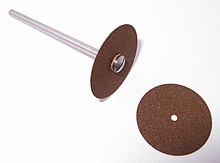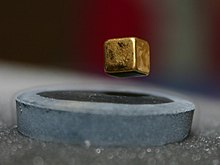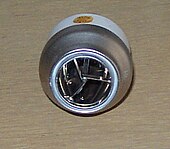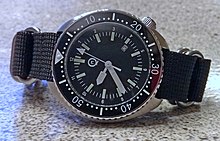Type a search term to find related articles by LIMS subject matter experts gathered from the most trusted and dynamic collaboration tools in the laboratory informatics industry.
A ceramic is any of the various hard, brittle, heat-resistant, and corrosion-resistant materials made by shaping and then firing an inorganic, nonmetallic material, such as clay, at a high temperature.[1][2] Common examples are earthenware, porcelain, and brick.
The earliest ceramics made by humans were fired clay bricks used for building house walls and other structures. Other pottery objects such as pots, vessels, vases and figurines were made from clay, either by itself or mixed with other materials like silica, hardened by sintering in fire. Later, ceramics were glazed and fired to create smooth, colored surfaces, decreasing porosity through the use of glassy, amorphous ceramic coatings on top of the crystalline ceramic substrates.[3] Ceramics now include domestic, industrial, and building products, as well as a wide range of materials developed for use in advanced ceramic engineering, such as semiconductors.
The word ceramic comes from the Ancient Greek word κεραμικός (keramikós), meaning "of or for pottery"[4] (from κέραμος (kéramos) 'potter's clay, tile, pottery').[5] The earliest known mention of the root ceram- is the Mycenaean Greek ke-ra-me-we, workers of ceramic, written in Linear B syllabic script.[6] The word ceramic can be used as an adjective to describe a material, product, or process, or it may be used as a noun, either singular or, more commonly, as the plural noun ceramics.[7]

Ceramic material is an inorganic, metallic oxide, nitride, or carbide material. Some elements, such as carbon or silicon, may be considered ceramics. Ceramic materials are brittle, hard, strong in compression, and weak in shearing and tension. They withstand the chemical erosion that occurs in other materials subjected to acidic or caustic environments. Ceramics generally can withstand very high temperatures, ranging from 1,000 °C to 1,600 °C (1,800 °F to 3,000 °F).

The crystallinity of ceramic materials varies widely. Most often, fired ceramics are either vitrified or semi-vitrified, as is the case with earthenware, stoneware, and porcelain. Varying crystallinity and electron composition in the ionic and covalent bonds cause most ceramic materials to be good thermal and electrical insulators (researched in ceramic engineering). With such a large range of possible options for the composition/structure of a ceramic (nearly all of the elements, nearly all types of bonding, and all levels of crystallinity), the breadth of the subject is vast, and identifiable attributes (hardness, toughness, electrical conductivity) are difficult to specify for the group as a whole. General properties such as high melting temperature, high hardness, poor conductivity, high moduli of elasticity, chemical resistance, and low ductility are the norm,[8] with known exceptions to each of these rules (piezoelectric ceramics, low glass transition temperature ceramics, superconductive ceramics).
Composites such as fiberglass and carbon fiber, while containing ceramic materials, are not considered to be part of the ceramic family.[9]
Highly oriented crystalline ceramic materials are not amenable to a great range of processing. Methods for dealing with them tend to fall into one of two categories: either making the ceramic in the desired shape by reaction in situ or "forming" powders into the desired shape and then sintering to form a solid body. Ceramic forming techniques include shaping by hand (sometimes including a rotation process called "throwing"), slip casting, tape casting (used for making very thin ceramic capacitors), injection molding, dry pressing, and other variations.
Many ceramics experts do not consider materials with an amorphous (noncrystalline) character (i.e., glass) to be ceramics, even though glassmaking involves several steps of the ceramic process and its mechanical properties are similar to those of ceramic materials. However, heat treatments can convert glass into a semi-crystalline material known as glass-ceramic.[10]
Traditional ceramic raw materials include clay minerals such as kaolinite, whereas more recent materials include aluminium oxide, more commonly known as alumina. Modern ceramic materials, which are classified as advanced ceramics, include silicon carbide and tungsten carbide. Both are valued for their abrasion resistance and are therefore used in applications such as the wear plates of crushing equipment in mining operations. Advanced ceramics are also used in the medical, electrical, electronics, and armor industries.

Human beings appear to have been making their own ceramics for at least 26,000 years, subjecting clay and silica to intense heat to fuse and form ceramic materials. The earliest found so far were in southern central Europe and were sculpted figures, not dishes.[11] The earliest known pottery was made by mixing animal products with clay and firing it at up to 800 °C (1,500 °F). While pottery fragments have been found up to 19,000 years old, it was not until about 10,000 years later that regular pottery became common. An early people that spread across much of Europe is named after its use of pottery: the Corded Ware culture. These early Indo-European peoples decorated their pottery by wrapping it with rope while it was still wet. When the ceramics were fired, the rope burned off but left a decorative pattern of complex grooves on the surface.

The invention of the wheel eventually led to the production of smoother, more even pottery using the wheel-forming (throwing) technique, like the pottery wheel. Early ceramics were porous, absorbing water easily. It became useful for more items with the discovery of glazing techniques, which involved coating pottery with silicon, bone ash, or other materials that could melt and reform into a glassy surface, making a vessel less pervious to water.
Ceramic artifacts have an important role in archaeology for understanding the culture, technology, and behavior of peoples of the past. They are among the most common artifacts to be found at an archaeological site, generally in the form of small fragments of broken pottery called sherds. The processing of collected sherds can be consistent with two main types of analysis: technical and traditional.
The traditional analysis involves sorting ceramic artifacts, sherds, and larger fragments into specific types based on style, composition, manufacturing, and morphology. By creating these typologies, it is possible to distinguish between different cultural styles, the purpose of the ceramic, and the technological state of the people, among other conclusions. Besides, by looking at stylistic changes in ceramics over time, it is possible to separate (seriate) the ceramics into distinct diagnostic groups (assemblages). A comparison of ceramic artifacts with known dated assemblages allows for a chronological assignment of these pieces.[12]
The technical approach to ceramic analysis involves a finer examination of the composition of ceramic artifacts and sherds to determine the source of the material and, through this, the possible manufacturing site. Key criteria are the composition of the clay and the temper used in the manufacture of the article under study: the temper is a material added to the clay during the initial production stage and is used to aid the subsequent drying process. Types of temper include shell pieces, granite fragments, and ground sherd pieces called 'grog'. Temper is usually identified by microscopic examination of the tempered material. Clay identification is determined by a process of refiring the ceramic and assigning a color to it using Munsell Soil Color notation. By estimating both the clay and temper compositions and locating a region where both are known to occur, an assignment of the material source can be made. Based on the source assignment of the artifact, further investigations can be made into the site of manufacture.
The physical properties of any ceramic substance are a direct result of its crystalline structure and chemical composition. Solid-state chemistry reveals the fundamental connection between microstructure and properties, such as localized density variations, grain size distribution, type of porosity, and second-phase content, which can all be correlated with ceramic properties such as mechanical strength σ by the Hall-Petch equation, hardness, toughness, dielectric constant, and the optical properties exhibited by transparent materials.
Ceramography is the art and science of preparation, examination, and evaluation of ceramic microstructures. Evaluation and characterization of ceramic microstructures are often implemented on similar spatial scales to that used commonly in the emerging field of nanotechnology: from nanometers to tens of micrometers (µm). This is typically somewhere between the minimum wavelength of visible light and the resolution limit of the naked eye.
The microstructure includes most grains, secondary phases, grain boundaries, pores, micro-cracks, structural defects, and hardness micro indentions. Most bulk mechanical, optical, thermal, electrical, and magnetic properties are significantly affected by the observed microstructure. The fabrication method and process conditions are generally indicated by the microstructure. The root cause of many ceramic failures is evident in the cleaved and polished microstructure. Physical properties which constitute the field of materials science and engineering include the following:

Mechanical properties are important in structural and building materials as well as textile fabrics. In modern materials science, fracture mechanics is an important tool in improving the mechanical performance of materials and components. It applies the physics of stress and strain, in particular the theories of elasticity and plasticity, to the microscopic crystallographic defects found in real materials in order to predict the macroscopic mechanical failure of bodies. Fractography is widely used with fracture mechanics to understand the causes of failures and also verify the theoretical failure predictions with real-life failures.
Ceramic materials are usually ionic or covalent bonded materials. A material held together by either type of bond will tend to fracture before any plastic deformation takes place, which results in poor toughness in these materials. Additionally, because these materials tend to be porous, the pores and other microscopic imperfections act as stress concentrators, decreasing the toughness further, and reducing the tensile strength. These combine to give catastrophic failures, as opposed to the more ductile failure modes of metals.
These materials do show plastic deformation. However, because of the rigid structure of crystalline material, there are very few available slip systems for dislocations to move, and so they deform very slowly.
To overcome the brittle behavior, ceramic material development has introduced the class of ceramic matrix composite materials, in which ceramic fibers are embedded and with specific coatings are forming fiber bridges across any crack. This mechanism substantially increases the fracture toughness of such ceramics. Ceramic disc brakes are an example of using a ceramic matrix composite material manufactured with a specific process.
Scientists are working on developing ceramic materials that can withstand significant deformation without breaking. A first such material that can deform in room temperature was found in 2024.[13]
If a ceramic is subjected to substantial mechanical loading, it can undergo a process called ice-templating, which allows some control of the microstructure of the ceramic product and therefore some control of the mechanical properties. Ceramic engineers use this technique to tune the mechanical properties to their desired application. Specifically, the strength is increased when this technique is employed. Ice templating allows the creation of macroscopic pores in a unidirectional arrangement. The applications of this oxide strengthening technique are important for solid oxide fuel cells and water filtration devices.[14]
To process a sample through ice templating, an aqueous colloidal suspension is prepared to contain the dissolved ceramic powder evenly dispersed throughout the colloid,[clarification needed] for example Yttria-stabilized zirconia (YSZ). The solution is then cooled from the bottom to the top on a platform that allows for unidirectional cooling. This forces ice crystals to grow in compliance with the unidirectional cooling, and these ice crystals force the dissolved YSZ particles to the solidification front[clarification needed] of the solid-liquid interphase boundary, resulting in pure ice crystals lined up unidirectionally alongside concentrated pockets of colloidal particles. The sample is then heated and at the same the pressure is reduced enough to force the ice crystals to sublime and the YSZ pockets begin to anneal together to form macroscopically aligned ceramic microstructures. The sample is then further sintered to complete the evaporation of the residual water and the final consolidation of the ceramic microstructure.[citation needed]
During ice-templating, a few variables can be controlled to influence the pore size and morphology of the microstructure. These important variables are the initial solids loading of the colloid, the cooling rate, the sintering temperature and duration, and the use of certain additives which can influence the microstructural morphology during the process. A good understanding of these parameters is essential to understanding the relationships between processing, microstructure, and mechanical properties of anisotropically porous materials.[15]
Some ceramics are semiconductors. Most of these are transition metal oxides that are II-VI semiconductors, such as zinc oxide. While there are prospects of mass-producing blue LEDs from zinc oxide, ceramicists are most interested in the electrical properties that show grain boundary effects. One of the most widely used of these is the varistor. These are devices that exhibit the property that resistance drops sharply at a certain threshold voltage. Once the voltage across the device reaches the threshold, there is a breakdown of the electrical structure[clarification needed] in the vicinity of the grain boundaries, which results in its electrical resistance dropping from several megohms down to a few hundred ohms. The major advantage of these is that they can dissipate a lot of energy, and they self-reset; after the voltage across the device drops below the threshold, its resistance returns to being high. This makes them ideal for surge-protection applications; as there is control over the threshold voltage and energy tolerance, they find use in all sorts of applications. The best demonstration of their ability can be found in electrical substations, where they are employed to protect the infrastructure from lightning strikes. They have rapid response, are low maintenance, and do not appreciably degrade from use, making them virtually ideal devices for this application. Semiconducting ceramics are also employed as gas sensors. When various gases are passed over a polycrystalline ceramic, its electrical resistance changes. With tuning to the possible gas mixtures, very inexpensive devices can be produced.

Under some conditions, such as extremely low temperatures, some ceramics exhibit high-temperature superconductivity (in superconductivity, "high temperature" means above 30 K). The reason for this is not understood, but there are two major families of superconducting ceramics.
Piezoelectricity, a link between electrical and mechanical response, is exhibited by a large number of ceramic materials, including the quartz used to measure time in watches and other electronics. Such devices use both properties of piezoelectrics, using electricity to produce a mechanical motion (powering the device) and then using this mechanical motion to produce electricity (generating a signal). The unit of time measured is the natural interval required for electricity to be converted into mechanical energy and back again.
The piezoelectric effect is generally stronger in materials that also exhibit pyroelectricity, and all pyroelectric materials are also piezoelectric. These materials can be used to inter-convert between thermal, mechanical, or electrical energy; for instance, after synthesis in a furnace, a pyroelectric crystal allowed to cool under no applied stress generally builds up a static charge of thousands of volts. Such materials are used in motion sensors, where the tiny rise in temperature from a warm body entering the room is enough to produce a measurable voltage in the crystal.
In turn, pyroelectricity is seen most strongly in materials that also display the ferroelectric effect, in which a stable electric dipole can be oriented or reversed by applying an electrostatic field. Pyroelectricity is also a necessary consequence of ferroelectricity. This can be used to store information in ferroelectric capacitors, elements of ferroelectric RAM.
The most common such materials are lead zirconate titanate and barium titanate. Aside from the uses mentioned above, their strong piezoelectric response is exploited in the design of high-frequency loudspeakers, transducers for sonar, and actuators for atomic force and scanning tunneling microscopes.
Temperature increases can cause grain boundaries to suddenly become insulating in some semiconducting ceramic materials, mostly mixtures of heavy metal titanates. The critical transition temperature can be adjusted over a wide range by variations in chemistry. In such materials, current will pass through the material until joule heating brings it to the transition temperature, at which point the circuit will be broken and current flow will cease. Such ceramics are used as self-controlled heating elements in, for example, the rear-window defrost circuits of automobiles.
At the transition temperature, the material's dielectric response becomes theoretically infinite. While a lack of temperature control would rule out any practical use of the material near its critical temperature, the dielectric effect remains exceptionally strong even at much higher temperatures. Titanates with critical temperatures far below room temperature have become synonymous with "ceramic" in the context of ceramic capacitors for just this reason.

Optically transparent materials focus on the response of a material to incoming light waves of a range of wavelengths. Frequency selective optical filters can be utilized to alter or enhance the brightness and contrast of a digital image. Guided lightwave transmission via frequency selective waveguides involves the emerging field of fiber optics and the ability of certain glassy compositions as a transmission medium for a range of frequencies simultaneously (multi-mode optical fiber) with little or no interference between competing wavelengths or frequencies. This resonant mode of energy and data transmission via electromagnetic (light) wave propagation, though low powered, is virtually lossless. Optical waveguides are used as components in Integrated optical circuits (e.g. light-emitting diodes, LEDs) or as the transmission medium in local and long haul optical communication systems. Also of value to the emerging materials scientist is the sensitivity of materials to radiation in the thermal infrared (IR) portion of the electromagnetic spectrum. This heat-seeking ability is responsible for such diverse optical phenomena as night-vision and IR luminescence.
Thus, there is an increasing need in the military sector for high-strength, robust materials which have the capability to transmit light (electromagnetic waves) in the visible (0.4 – 0.7 micrometers) and mid-infrared (1 – 5 micrometers) regions of the spectrum. These materials are needed for applications requiring transparent armor, including next-generation high-speed missiles and pods, as well as protection against improvised explosive devices (IED).
In the 1960s, scientists at General Electric (GE) discovered that under the right manufacturing conditions, some ceramics, especially aluminium oxide (alumina), could be made translucent. These translucent materials were transparent enough to be used for containing the electrical plasma generated in high-pressure sodium street lamps. During the past two decades, additional types of transparent ceramics have been developed for applications such as nose cones for heat-seeking missiles, windows for fighter aircraft, and scintillation counters for computed tomography scanners. Other ceramic materials, generally requiring greater purity in their make-up than those above, include forms of several chemical compounds, including:
For convenience, ceramic products are usually divided into four main types; these are shown below with some examples:[17]
Frequently, the raw materials of modern ceramics do not include clays.[19] Those that do have been classified as:
Ceramics can also be classified into three distinct material categories:
Each one of these classes can be developed into unique material properties.

